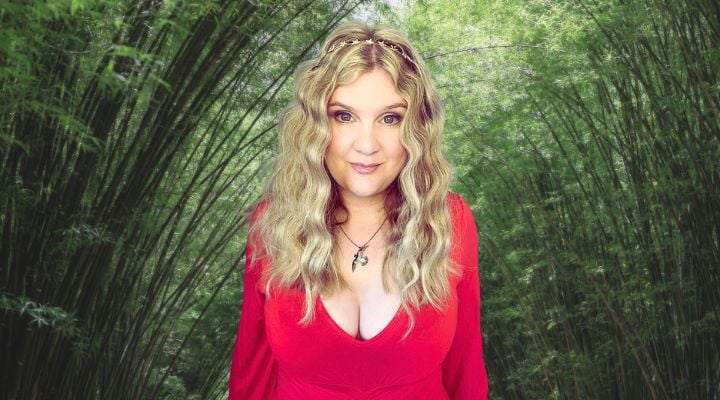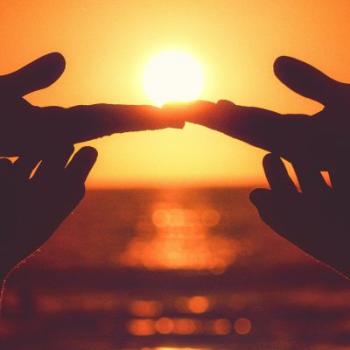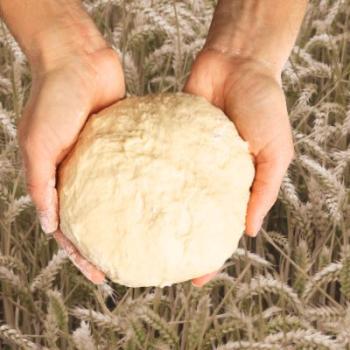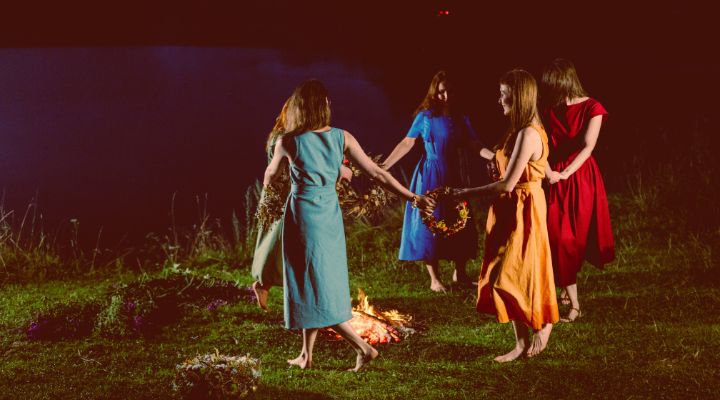
Firstly, there’s no wrong way to write a ritual. You can design your witchcraft and pagan rites any way that works for you.
But if you aren’t part of a tradition or you’d like to do things differently to the traditions you’ve trained within, how do you start over?
When I first started practising paganism (many moons ago!) most books (websites were fewer back then) used ritual formats which were based on the Wiccan style:
- Purify your space
- Cast a circle
- Call in the elements
- Invoke one male and one female deity
- Raise some energy
- Have some quiet time for inner work
- Listen to a poem or song
- Bless the cakes and wine then share them
- Repeat some of the steps to close the circle
Different authors experimented with changing things up a little, maybe making it “less Wiccan”. For example, some heathens chose to cast a square with elements in the corners rather than a circle, a practise that earned the affectionate nickname of “Wiccatru”
But for the most part, people stuck to this ritual pattern because it worked and it was easy to build what they needed from their magical practise into this structure.
And indeed, Gerald Gardner didn’t create this format all on his own.
Elements of the Wiccan ritual can be found in occultism and freemasonry and as far back as Egyptian and Greek paganism. The modern pagan ritual has evolved into this structure over time, and this is part of the reason why it works well for so many practitioners.
We don’t have to do ritual this way, especially if we’ve stepped away from the traditions, we trained in.
Putting your own rites together without that set structure can seem daunting, however.
Which is why I took some time to deconstruct what makes a good ritual and put together my own formula.
This uses six stages to ensure an efficient ritual flow. It fits many different uses, but you’ll probably find it easier to tweak it to make it fit your needs more closely.
- Safety
- Rapport/ Co-regulation
- Connection
- The Magic
- Grounding
- End Feeling

And here’s how I work with each of these stages:
Safety
For people to connect and share space with others it’s important for them to feel safe. When working in a solitary way you might find the same thing, you want to create a feeling of safety within your environment before you start.
This could involve designating a sacred space. It could also include purifying that space. It might include relaxation and grounding exercises. The idea is to create a head space and working area that feels ready to do magic in. This helps to build that sense of safety.
Casting a circle is by no means the only way to do this. But if you’re working with a group of people who usually use a circle, they might expect one. By deliberately removing that step you might find you need to work much harder to create a feeling of safety. That’s not to say you must have a circle but think carefully about the benefits of keeping one as opposed to removing it.
Rapport/ Co-regulation
This is the sense of flowing together. It’s less important when you’re working on your own, but you might want to think of this as getting your body and mind ready to start connecting.
The Farrar Wiccan rites include the Witches Rune here. It “builds energy” sure, but what it also does is bring the group together chanting and moving as one.
In church ceremonies you might start with a hymn, again allowing the congregation to come together, joining voices.
Some groups will add a ritual practise which is specific to them here.
If you have less mobile (or like me, less co-ordinated) people, you might choose to use a song rather than a dance. You could replace it with a chant if your group don’t feel comfortable singing. If your group tends towards more introversion, you could use breathing together or some gentle movement.
Singing and chanting stimulates the vagus nerve which sends messages of safety and socialisation, therefore if you’re replacing this think about what else you can do to create the same effect.
Connection
I thought a lot about whether this stage is essential. It reflects the connection with “the other”, spirit, or deity, or land energy. And I recognise not everyone will use this element in their ritual. Connecting with something other than the everyday and mundane is a big part of what makes ritual into something outside of the normal experience. This makes it a key stage of what makes your practise ritual.
Whilst connection doesn’t have to be to something esoteric or spiritual, I think it’s a key part of accessing an altered state. You can work to connect to your subconscious, or your higher self. Or you can build a deeper connection energetically to the people within the space with you.
Connection can take the form of an invocation, a meditation/ pathworking, a drum journey, or maybe just some quiet contemplation.
The Magic
This is the part of the ritual where you complete “the work”.
Whatever the purpose of the rite, this is when it happens. I like to think of this part as being more active than the connection stage, but this doesn’t mean the two can’t segway neatly into each other. For example, if the main part of your ritual was going to be inner work and pathworking based you could build the magic into that by creating a part where you take action. This could be cord cutting, or releasing energy, or stating a goal or affirmation.
In a traditional “esbat” or “moon rite” type ritual you could look at the spell aspect as the magic. In an open ritual you could look at the part where the congregation are asked to complete a task, such as planting a seed or lighting a candle. You could even add divination here, like a tarot or rune reading, or maybe some scrying.
Grounding
Whilst you may have “released” a lot of the energy raised in the ritual during the magic section, you still want to bring yourself (and your participants if you’re running a group ritual) back into an everyday head space. Transitioning from the ritual to the mundane.
When I first started practising witchcraft and leading guided meditations, I was taught to bring people back by taking them through each of the steps they’d taken within the pathworking. But when training to be a hypnotherapist, I was taught that wasn’t important, so long as you brought them from trance to everyday consciousness slowly enough. I guess the retracing your footsteps is designed to implement that time transition, but if you’re led through it superfast maybe it doesn’t?
I believe the ritual state of mind is different to the mundane. And therefore, we need to build in transition time and specific steps to signal to the mind we’re coming back to our normal consciousness.
Cakes and wine are a great way to do this, as is taking the steps you took at the beginning of the ritual to make the space sacred. As someone who doesn’t drink alcohol and can’t eat dairy, I recognise there’s room for lots of unintentional exclusion with this, however. In some kinds of Wicca, you would do the circle casting steps the opposite way round to un-cast the circle.
Chanting or putting your hands/ head to the ground is also often used. As is a feeling of connection between each member of the circle (hugs, or a group hug).
End Feeling
Put simply, what emotion or message do you want to leave the ritual with? And how long will that emotion last?
Think about the rituals you really remember as being effective and significant. Often these will be the ones where you walked away from them with a feeling you held onto. What happened to create that? What we build into the last moments of our rite stays in thoughts and hearts. Adding a last connection (back to the hugs…) or a poignant sentence or poem can shape the lasting sense that ritual leaves us with.
If you’ve included a lot of ecstatic elements to your ritual, you might want to think about extending the “end” by getting in touch with your participants the next day. Or by adding an additional step to the rite later.
This is because some types of ritual can artificially raise the dopamine/ serotonin/ oxytocin levels in the brain. And when they rise quickly during something we don’t usually do, the “crash” when they go back to normal can feel almost as extreme.
Allowing the dopamine levels to go back to normal slowly helps us to not experience a post ritual crash. So, adding a step the next day (planting your seed in the garden for example, or lighting your candle at a specified time) helps you to add another tiny good-feelings spike which allows a gentler step back into normality.
You can also send a message out to participants a certain time after the rite to remind them how wonderful it was and how connected you all still are.
This structure is simply a guideline I’ve put together for myself based on unpicking pagan rituals and the way other religious ceremonies are structured and noting points of similarity.
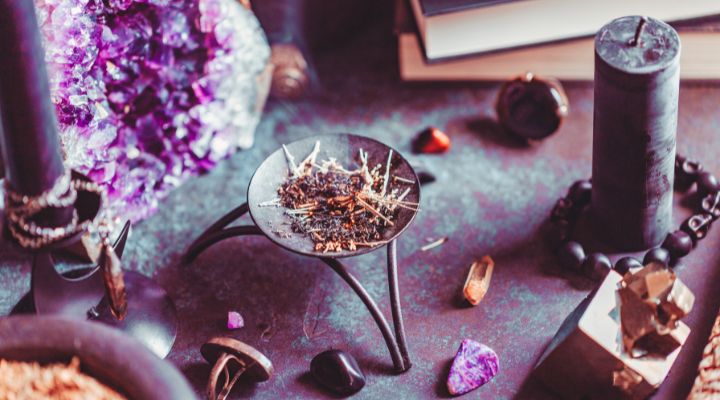
There’s no “right” way to “rite”
but it might be helpful for you to consider these elements to give a starting point when moving away from the paths you trained within.
And if you come up with something that works better, let me know so I can learn from you!

